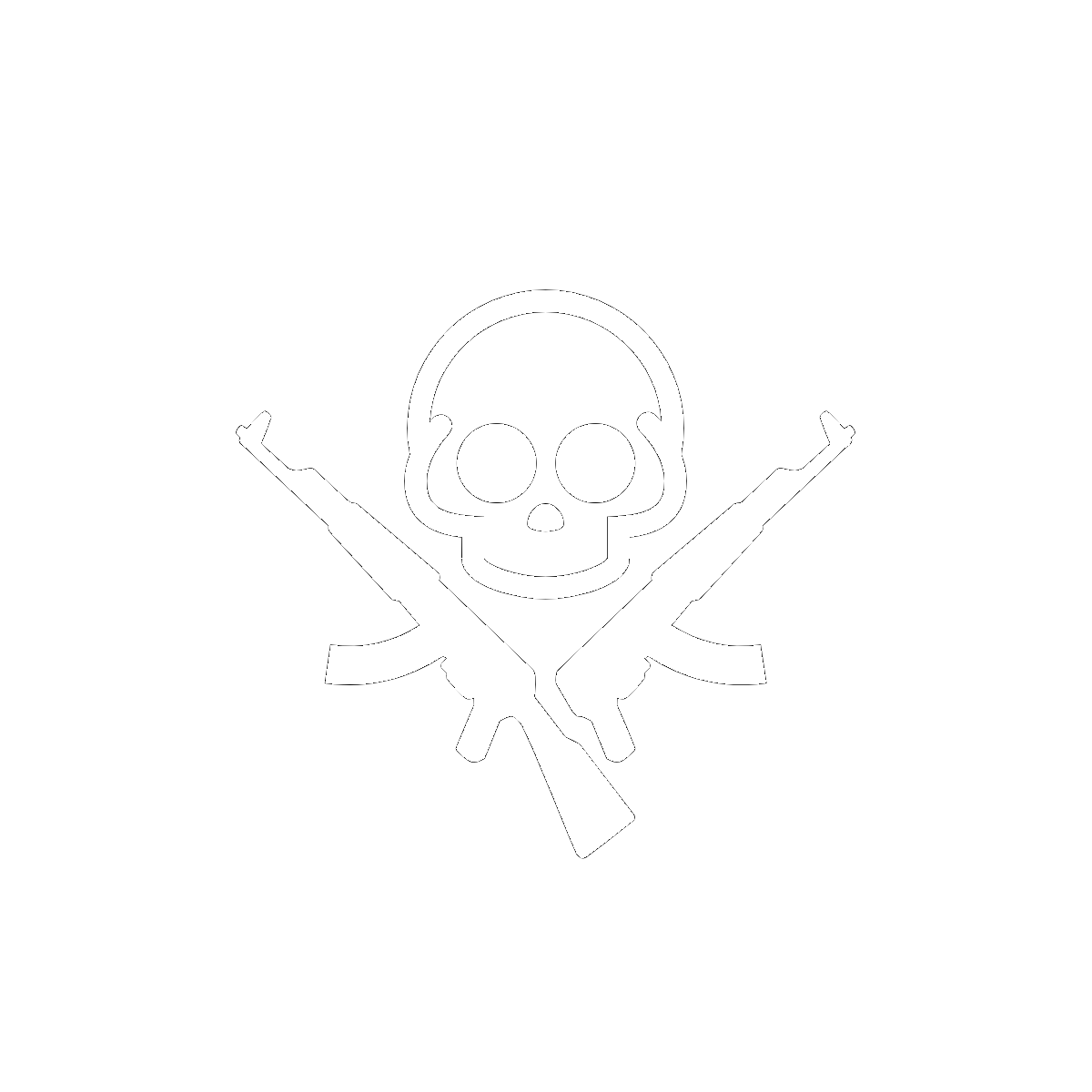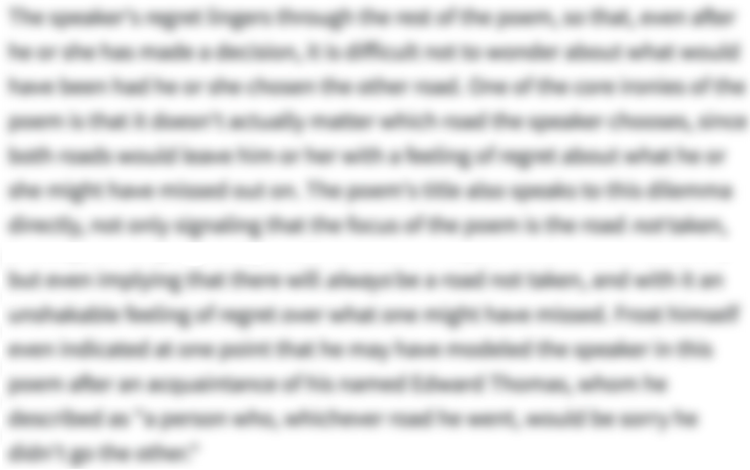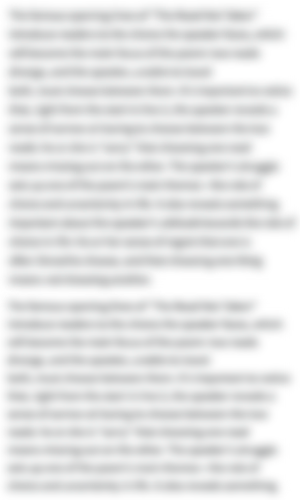-
“The Death of the Ball Turret Gunner” Introduction
-
The American writer Randall Jarrell published "The Death of the Ball Turret Gunner" in 1945, the final year of World War II. The poem's speaker suggests that he slips from the protection of his mother's womb into "the State," where he finds himself in a ball turret (the round compartment on a bomber plane from which a gunner shoots). Metaphorically presenting the turret as another kind of womb, the speaker implies that he's as helpless as a baby—a comment on the vulnerability of innocent young men who suddenly find themselves facing the horrors of war. The final line, in which the military matter-of-factly rinses the dead speaker's remains from the plane, is a grim reflection on the way war treats young soldiers as expendable pieces of equipment.
-
-
“The Death of the Ball Turret Gunner” Summary
-
From the peaceful protection of my mother (or even from inside her womb—a metaphor for the security of childhood), I was flung helplessly into the control of the government. I hunkered down in its guts (an image of its inner workings) until my wet "fur" (my soft hair and body still wet from birth) froze solid.
In an airplane six miles above the ground, disconnected from the illusions of everyday life, I awakened to the harsh reality of enemy fire and monstrous fighter planes.
After I died, the military rinsed my destroyed body out of the gunner's cockpit with a hose.
-
-
“The Death of the Ball Turret Gunner” Themes
-

The Dehumanization of War
“The Death of the Ball Turret Gunner” highlights the government's power to sweep people up into war. The speaker of the poem knows this all too well: he unwittingly “fell” into the “nightmare” of a ball turret—a small spherical chamber on the underside of World War II bomber planes, in which a soldier sits and shoots at enemies. To make matters worse, the very government that put the speaker in harm’s way doesn’t care what happens to him, simply washing his bloody remains from the turret after he dies. By implying that the government sees the speaker as expendable, the poem criticizes the dehumanization inherent to institutionalized violence.
The fact that the speaker abruptly drops into a dangerous combat zone suggests that there’s a certain societal machinery that funnels people into war. It seems there’s no way for young men like the speaker to escape the power of “the State,” which can pluck people from the safety of their youthful lives and throw them into the harrowing world of combat.
The poem also suggests that “the State” doesn’t even appreciate the sacrifice people like the speaker are forced to make when they fight in the military. To be a ball turret gunner would take considerable bravery, but nobody seems to acknowledge the speaker’s courage. Instead, they unceremoniously wash him “out of the turret with a hose” when he dies, as if his remains are nothing but a pesky mess to clean up.
This emphasizes the impersonal nature of “the State,” indicating that the government has the power to not only send the speaker to war, but to "wash away" his entire life. Through this, the poem criticizes not just the apathy and power of “the State,” but also the dehumanization of war. War, the poem implies, encourages governments to treat soldiers like they’re disposable.
Where this theme appears in the poem:- Lines 1-2
- Lines 4-5
-

The Vulnerability and Innocence of Soldiers
Because the speaker is dead, the poem is—in many ways—about the people and institutions that failed to protect him in life. Taken from the protection of his mother and thrown into the “belly” of a ball turret, he metaphorically moves from one womb to the next. Wombs are (generally speaking) safe places of growth and nourishment, but this isn’t the case in “The Death of the Ball Turret Gunner.” Neither his mother’s womb nor the “belly” of “the State” can actually protect the speaker. Everything in his life, then, fails him: his mother fails to protect him from the government, and the government fails to protect him from death.
The poem is thus a bleak portrait of the kind of vulnerability soldiers experienced during World War II—a portrait that hints at the fact that many innocent, naïve soldiers were unprepared for the ghastly reality of war when they went off to combat.
The speaker is helpless throughout the entire poem, as if he’s a baby at the mercy of the people around him. He’s especially vulnerable during his mother’s “sleep,” when he falls “into the State.” Unsupervised by his protector, he suddenly finds himself in danger and appears completely incapable of doing anything to defend himself.
In this way, the poem deliberately treats the soldier like a child so that readers see him as an innocent victim of a merciless war. This serves as a possible illustration of the fact that so many families let their unsuspecting, unprepared children go off to die in the carnage of World War II.
At the same time, the image of the speaker “hunched” in the “belly” of “the State” subtly suggests that the military is the speaker’s new protector. To build on this idea, the speaker says that his “wet fur froze,” presenting himself as some kind of animal carried deep inside a stronger, bigger animal (this mention of fur could also refer to the fur lining of an aviator jacket). But the speaker’s fur freezes, indicating that he’s not in a place of warm support. Instead, he’s in a ball turret facing the “black flak” of enemy ammunition—a clear sign that the military has failed to keep him safe. In fact, it has put him in harm’s way.
The speaker’s vulnerability is further intensified by his own passivity. When he says, “I woke to black flak and the nightmare fighters,” the poem implies that he was sleeping in an active battle zone. This emphasizes the idea that he is at the total mercy of his surroundings, illustrating the helplessness and the lack of control that many young soldiers must have experienced when they encountered the horrors of World War II.
Where this theme appears in the poem:- Lines 1-5
-
-
Line-by-Line Explanation & Analysis of “The Death of the Ball Turret Gunner”
-
Line 1
From my mother’s ... into the State,
In this poem's strange, disorienting first line, the speaker claims to have fallen "into the State" from his "mother's sleep." As that capitalization suggests, the speaker uses "the State" as a metonym for the government. This invites readers to imagine a government that has great power over the speaker—that controls the speaker, forces the speaker to act as the government wants, and doesn't much care about the speaker in return. After all, he doesn't choose to enter "the State," but helplessly falls into it, as if it were inevitable that he would eventually find himself at its mercy.
Although it's clear that "the State" is the speaker's way of referring to the government, the phrase "my mother's sleep" is more mysterious. The most literal interpretation is that the speaker slips from his mother's protection while she isn't paying attention—that is, while she's sleeping. But as the poem goes on, another possibility emerges: that the phrase "my mother's sleep" refers to the peaceful and safe environment of his mother's womb, implying that the speaker is a baby who goes directly from infancy to the harsh care of the government.
Because "The Death of the Ball Turret Gunner" gets pretty abstract and metaphorical, it's worth keeping its simplest meaning in mind. On its most basic level, this poem is about the speaker's experience of active combat in World War II, curled inside a ball turret, a compartment attached to the underside of a bomber plane. A soldier would crouch inside the ball turret (in a position similar to a baby crouched in its mother's womb), shooting machine guns to protect the plane from enemy fire. Although it doesn't become clear until later in the poem that the speaker finds himself in a turret, the title—"The Death of the Ball Turret Gunner"—prepares readers for this fact, and it helps to keep this context in mind when considering the poem's more complex moments. The poem, then, connects the baby in the womb to the man in the ball turret, and uses that juxtaposition to highlight the absurdity and horror of a man forced by his country to go to war.
The speaker's language in this opening line uses an intense sequence of repeated sounds, starting with the consonant /m/: "From my mother's sleep I fell into the State." This /m/ sound is particularly noticeable because the phrase "my mother's" is also alliterative, giving the opening words of the poem a rhythmic bump. Then the consonant /l/ sound in "sleep" and "fell" and the sibilant /s/ sound in "sleep" and "State" come in. All together, these repetitions make this first line feel startling, vivid, and intense—just as intense as finding oneself falling without warning out of one's mother's protection and "into the State."
-
Line 2
And I hunched ... wet fur froze.


Unlock all 322 words of this analysis of Line 2 of “The Death of the Ball Turret Gunner,” and get the Line-by-Line Analysis for every poem we cover.
Plus so much more...
Get LitCharts A+ -
Lines 3-4
Six miles from ...
... the nightmare fighters. -
Line 5
When I died ... with a hose.
-
-
“The Death of the Ball Turret Gunner” Symbols
-

The Ball Turret
The ball turret symbolizes the machinery of war, as well as the government's lack of concern for the safety of its own soldiers. The poem presents the turret as a womb of sorts, suggesting that the speaker "hunche[s] in its belly" like an unborn animal or fetus. Generally speaking, people think of wombs as safe, nurturing places, but this isn't the case in the ball turret. Rather than protecting the speaker from danger and nourishing him, the ball turret takes him away from any semblance of safety—a representation of how the US government convinced many unsuspecting young men out of their family homes and into the danger of World War II.
Once the speaker leaves his mother's care, the ball turret launches him "six miles from earth," where he faces gunfire from "nightmare fighters." It's clear, then, that the turret completely fails to keep the speaker safe, instead putting him directly in harm's way. Given that the turret represents "the State," this implies that the government is unconcerned with the speaker's wellbeing. His gruesome death inside the turret symbolizes the government's willingness to put defenseless soldiers in harm's way. And the fact that the Air Force unceremoniously sprays the speaker's remains from the turret after he dies suggests that the literal machinery of war—that is, pieces of equipment like the ball turret—are more important to the government than actual human lives.
Where this symbol appears in the poem:- Lines 1-2
- Line 5
-
-
“The Death of the Ball Turret Gunner” Poetic Devices & Figurative Language
-
Metaphor
"The Death of the Ball Turret Gunner" uses intense metaphors of wombs, dreams, and awakenings to evoke the speaker's innocence—and his terrible death.
Right from the start, the poem metaphorically connects the speaker's experience as a ball turret gunner to the experience of being inside a womb. This becomes particularly clear when the speaker says that he "hunche[s]" in the "belly" of "the State," creating an image of himself curled inside a living thing. In this image, the ball turret (which here represents the government) is alive. What's more, it has taken over responsibility for him. In other words, he goes straight from his mother's womb to the womb of the ball turret. When he metaphorically "[falls] into the State," it seems as if he's just stumbling into this war, defenseless and vulnerable as a baby.
And like a baby in the womb, he seems to be unconscious—until he wakes to find himself "Six miles from earth" in a warplane. Up here, he's "loosed" from the "dream of life"—that is, the illusions of life down on earth. Because the poem is about what it was like for naïve young soldiers to go off to World War II, perhaps this "dream of life" is a metaphor for the way the US government drew people into the military with unrealistic visions of valor, romanticizing war and turning it into a fantasy (a "dream") of courage and heroism. That dream ends when the enemy starts shooting at the speaker; in contrast with the metaphorical "dream," those enemies are part of a new, terrible "nightmare."
The poem's final line ("When I died [...] a hose") builds on the metaphor of the speaker as an unborn infant, this time subtly suggesting that he died in the womb and that his new mother (the ball turret) has a stillbirth or abortion. This only emphasizes the fact that he never truly got to act for himself. Like an innocent baby, he has no way of defending himself, and none of his protectors (neither his mother nor "the State") end up keeping him safe from the horrors of war.
Where metaphor appears in the poem:- Line 1
- Line 2
- Line 3
- Line 5
-
Alliteration


Unlock all 197 words of this analysis of Alliteration in “The Death of the Ball Turret Gunner,” and get the poetic device analyses for every poem we cover.
Plus so much more...
Get LitCharts A+ -
Consonance
-
Assonance
-
Onomatopoeia
-
End-Stopped Line
-
-
“The Death of the Ball Turret Gunner” Vocabulary
Select any word below to get its definition in the context of the poem. The words are listed in the order in which they appear in the poem.
- The State
- Fur
- Loosed
- Flak
- Turret
The State-
(Location in poem: Line 1: “the State”)
In this context, "the State" refers to the government—and, more specifically, the US government during World War II.
-
Form, Meter, & Rhyme Scheme of “The Death of the Ball Turret Gunner”
-
Form
"The Death of the Ball Turret Gunner" uses a single five-line stanza, and doesn't adhere to any specific poetic form, like the sonnet or the sestina.
This deceptively simple structure makes room for the poem's intense, abstract content. Short, plain lines, all about the same length, bring the poem's complex metaphors right to the front, asking readers to pay careful attention to each image.
-
Meter
The poem doesn't use a consistent meter, but it does have strong rhythmic moments. Although it's technically written in free verse, the poem flirts with a loose form of pentameter, a meter in which each line has five separate metrical feet. But the rhythms here are disrupted and irregular, as jarring as the unfortunate speaker's experiences.
Consider, for example, the metrical differences between the first two lines:
From my moth- | er's sleep | I fell | into | the State,
And I hunched | in its bell- | y till | my wet | fur frozeThe first foot of this line is an anapest (da-da-DUM), and the fourth is a trochee (DUM-da), but much of the rest of the line eases into an iambic (da-DUM) bounce.
At first, it seems as if the second line is going to do something similar. But then, the speaker uses two anapests in a row: "And I hunched | in its bell-." The line also ends with a spondee, or two consecutive stressed syllables: "fur froze." This irregular rhythm makes the poem feel jarring and ominous, much like war itself. As the poem goes on, the reader begins to feels that those five stressed syllables will arrive—but can never predict when.
Even though the poem doesn't follow a uniform meter, some of its stresses are particularly noticeable. The phrase "black flak," for example, has a staccato effect that imitates the rat-tat of incoming gunfire. Similarly, the stress on the word "died" intensifies the drama of the final line: "When I died [...]."
By varying the rhythm throughout the poem, but always using five stresses per line, the speaker evokes the anxiety and uncertainty of war—but also its deadly inevitability.
-
Rhyme Scheme
"The Death of the Ball Turret Gunner" doesn't follow a regular rhyme scheme. It does, however, use internal rhymes to add music and intensity to the language. For example, line 4 includes an internal rhyme between the words "black" and "flak":
I woke to black flak and the nightmare fighters.
This rhyme is very noticeable, since the two words appear right next to each other (creating an onomatopoeic sound that resembles machine gun fire). The sonic effect of this moment becomes even more intense at the end of the line, where assonance on the /i/ sound links "nightmare" and "fighters."
There is also an end rhyme between the word "froze" in line 2 ("And I hunched [...] fur froze") and the word "hose" in the poem's final line ("When I died [...] a hose"). This rhyme subtly unifies the poem, and also calls attention to the change that the speaker has undergone. When he first falls into the ball turret, he says that his "fur" freezes solid—but by the end of the poem, he is nothing but a gory liquid to be rinsed out. The end rhyme between lines 2 and 5 highlights the tragic fact that his life has been completely "washed" away.
-
-
“The Death of the Ball Turret Gunner” Speaker
-
Perhaps the most striking thing about the speaker of "The Death of the Ball Turret Gunner" is that he is, as the title suggests, dead. At the end of the poem, he is washed out of the ball turret in which he died, meaning that the voice narrating these events reaches from beyond the grave.
Given that the speaker appears to have been in the Air Force in World War II (judging by the fact that this is when the Air Force used ball turrets), it's safe to assume that he is a man, since women weren't part of aerial bomber crews at that time. Randall Jarrell himself served in the Air Force during World War II, so it's also possible that his own experiences of the war inform this poem.
Whoever this speaker is, he leads a short and tragic life. He goes directly from his "mother's sleep" to the "belly" of a government at war. He obviously has very little personal agency, and this image underlines the idea that many innocent young soldiers put themselves at the complete mercy of their government by going to war for their country. It also subtly suggests that soldiers often joined the military without fully thinking through the consequences—consequences that were, judging by the speaker's gruesome death, very serious.
-
-
“The Death of the Ball Turret Gunner” Setting
-
The poem takes place sometime between 1943 and 1945, when the United States Air Force started bombing Nazi Germany in an effort to finally end World War II. The poem plays out inside a ball turret on the underside of a bomber plane, where the speaker suddenly finds himself high in the sky before encountering enemy fire.
Because the poem focuses on the speaker's abrupt transition from his mother's protection to the frightening confines of the ball turret during war, it's hard to say where, exactly, he is. Suffice it to say, he is somewhere above Nazi Germany in a ball turret—a ball turret in which he dies.
-
-
Literary and Historical Context of “The Death of the Ball Turret Gunner”
Literary Context
Because "The Death of the Ball Turret Gunner" is about war, it belongs to a literary tradition devoted to examining and exposing the horrors of violent combat. Poets have been writing about war since the days of Homer (who chronicled the Trojan War in The Iliad), and the first half of the 20th century was particularly full of literature about combat, as poets struggled to make sense of the harrowing violence of both World War I and World War II.
In World War I, poets like Siegfried Sassoon, Wilfred Owen, and Rupert Brooke wrote extensively about trench warfare, outlining the visceral, in-your-face violence of the front lines. Poems like Alan Seeger's "I Have a Rendezvous with Death," Wilfred Owen's "Dulce et Decorum Est," and Siegfried Sassoon's "Attack" all center around the gruesome intensity of fighting on the ground in World War I.
The poetry of World War II, however, is a bit different. The nature of war itself changed significantly between World War I and World War II, as new forms of technology made it possible to fight on a much larger scale. For this reason, many of the poems written about World War II focus on its fearsome machinery. Poems like Henry Reed's "Naming of Parts" and Oscar Williams's "On the Summer Sky the Airship Hangs" focus very specifically on the tools and vessels used for killing. Similarly, "The Death of the Ball Turret Gunner" takes place inside a ball turret—a piece of combat technology that was new at the time.
"The Death of the Ball Turret Gunner" is also unique because it signals a shift away from some of the most popular styles of Modernist poetry in the first half of the 20th century. Where poems like T. S. Eliot's "The Waste Land" took a maximalist, sprawling approach, Jarrell's "The Death of the Ball Turret Gunner" leaves some of its most important ideas unsaid. But this brevity is nothing like the Imagist poetry of people like William Carlos Williams, whose brief, simple poems like "This Is Just To Say" explored everyday life. By taking on heavy themes related to war and suffering in such a short format, Jarrell combined the apparent simplicity of the Imagist movement with the intensity of Modernist poems like "The Waste Land."
Historical Context
Randall Jarrell published "The Death of the Ball Turret Gunner" in 1945—the year the Nazis were finally defeated and World War II came to an end. One way that the Allied forces weakened the Nazis and stopped them from continuing their expansion was by bombing their resources. The fact that the poem takes place in the ball turret of an Ally bomber plane thus ties the speaker's experience to the eventual defeat of the Nazis.
A new piece of technology at the time, the ball turret was a small spherical compartment attached to the underside of certain kinds of American bomber planes. Because there wasn't much space inside the turret, the smallest member of the crew was usually assigned to the position of ball turret gunner—a particularly vulnerable and dangerous position, since the turret was more or less unprotected on the bottom of the plane. To add to this feeling of vulnerability, the gunner had to sit in the fetal position while operating the guns, which is likely why Jarrell metaphorically presents the turret as a womb.
Although Ally bomber planes played a significant role in the fall of Nazi Germany, "The Death of the Ball Turret Gunner" is not a celebration of the Air Force's victories. Instead, the poem focuses on the speaker's terrifying experience in the military and his gruesome death, spotlighting what must have been a very common feeling for young soldiers in World War II: a total unpreparedness to meet the harsh realities of war.
-
More “The Death of the Ball Turret Gunner” Resources
-
External Resources
-
The Death of Randall Jarrell — An interesting essay in Virginia Quarterly Review about Randall Jarrell's own untimely death.
-
Hear the Poem — A reading of the poem, along with images of ball turrets during World War II.
-
More About the Ball Turret — For more information about the use of the ball turret in World War II, check out this very short documentary about the technology and the men who used it.
-
The Poet's Voice — Hear a recording of Randall Jarrell reading his own poetry at the 92nd Street Y in New York City.
-
Jarrell's Life and Work — Learn more about Randall Jarrell in this brief overview of his life and work.
-
-








